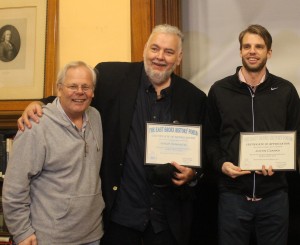
(left to right, Tom Casey, secretary of the East Bronx History Forum, Philip Panaritis, Project Director of Teaching American History and Justin Czarka, teacher at the Joseph Rodman Drake School in Hunts Point)
Three years ago, when I first became fascinated with Bronx history, I visited the Joseph Rodman Drake Park, a burial ground, on Oak Point Avenue in the Hunts Point area.
I had worked in the area when I was younger, and knew the area pretty well, yet had no idea there was a cemetery nearby. Turns out, I’m not alone. Most folks I speak with, even those living in the area, do not know it exists.
In the 17th century, the Hunt family, for whom Hunts Point is named, owned the land. American poet Drake spent some of his childhood at the Hunt home. He was only 25 when he died of tuberculosis. The park, owned and maintained by NYC Parks Department, contains tombstones of the Hunt, Leggett, Tiffany and Willet families, as well as Drake.
If you are familiar with the area you will notice that nearby streets bear the names of these families. Interestingly enough, in honor of Drake, other streets bear the names of poets – Henry Wadsworth Longfellow, John Greenleaf Whittier and Fitz-Greene Halleck.
Last night, at the East Bronx History Forum meeting, Philip Panaritis and Justin Czarka presented the Hunts Point Slave Burial Ground project (HPSBG).
Mr. Czarka, a teacher at the Joseph Rodman Drake Elementary school, and his students, viewed several pictures released by the Museum of the City of the New York in 2010. One of the photographs depicted a “Slave Burial Ground” on “Hunts Point Rd”. With the assistance of Mr. Panaritis, Project Director of Teaching American History, funding was secured and Czarka was able to duplicate maps, census reports and photographs for his students to conduct their studies.
Last year the U.S. Department of Agriculture conducted a study on the portion of the land the students believed the burial ground was located. Sure enough, the soil studies, which included ground-penetrating radar machines, revealed “anthropogenic features”, signs of human activity.
The HPSBG project is currently seeking to create public awareness of this finding, with a long term goal of signage, or perhaps a memorial, and the identification of those buried whose lives have been obliterated from local history. The history of these Indians and African Slaves MUST be preserved.
For more information, please visit http://hpsbg.weebly.com/













Follow Us